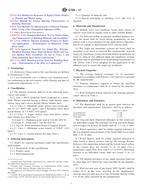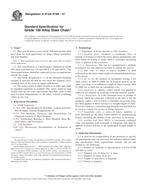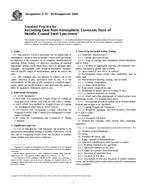1.1 This guide covers procedures for obtaining laboratory data concerning the adverse effects of an aqueous effluent on certain species of freshwater and saltwater fishes, macroinvertebrates, and amphibians usually during 2 to 4-day exposures, depending on the species, using the static, renewal, and flow-through techniques. These procedures will probably be useful for conducting acute toxicity tests on aqueous effluents with many other aquatic species, although modifications might be necessary.
1.2 Other modifications of these procedures might be justified by special needs or circumstances. Although using appropriate procedures is more important than following prescribed procedures, results of tests conducted using unusual procedures are not likely to be comparable to results of many other tests. Comparison of results obtained using modified and unmodified versions of these procedures might provide useful information concerning new concepts and procedures for conducting acute toxicity tests on aqueous effluents.
1.3 This guide is based in large part on Guide E 729. The major differences between the two guides are ( 1) the maximum test concentration is 100 % effluent or ambient sample, (2) testing is not chemical specific, and (3) the holding time of effluent and ambient samples is often considerably less that that for chemicals and other test materials. Because the sample is often a complex mixture of chemicals, analytical tests cannot generally be used to confirm exposure concentrations.
1.4 Selection of the technique to be used in a specific situation will depend upon the needs of the investigator and upon available resources. Static tests provide the most easily obtained measure of acute toxicity, but should not last longer than 48 h. Renewal and flow-through tests may last longer than 48 h because the pH and concentrations of dissolved oxygen and effluent are maintained at desired levels and degradation and metabolic products are removed. Static tests might not be applicable to effluents that have a high oxygen demand, or contain materials that ( 1) are highly volatile, (2) are rapidly biologically or chemically transformed in aqueous solutions, or (3) are removed from test solutions in substantial quantities by the test chambers or organisms during the test. Flow-through tests are generally preferable to renewal tests, although in some situations a renewal test might be more cost-effective than a flow-through test.
1.5 In the development of these procedures, an attempt was made to balance scientific and practical considerations and to ensure that the results will be sufficiently accurate and precise for the applications for which they are commonly used. A major consideration was that the common uses of the results of acute tests on effluents do not require or justify stricter requirements than those set forth in this guide. Although the tests may be improved by using more organisms, longer acclimation times, etc., the requirements presented in this guide should usually be sufficient.
1.6 Results of acute toxicity tests should usually be reported in terms of a median lethal concentration (LC50) or median effective concentration (EC50). In some situations, it might be necessary only to determine whether a specific concentration is acutely toxic to the test species or whether the LC50 or EC50 is above or below a specific concentration.
1.7 This guide is arranged as follows:
| Section | |
| Referenced Documents | 2 |
| Terminology | 3 |
| Summary of Guide | 4 |
| Significance and Use | 5 |
| Hazards | 7 |
| Apparatus | 6 |
| Facilities | 6.1 |
| Special Requirements | 6.2 |
| Construction Materials | 6.3 |
| Metering System | 6.4 |
| Test Chambers | 6.5 |
| Cleaning | 6.6 |
| Acceptability | 6.7 |
| Dilution Water | 8 |
| Requirements | 8.1 |
| Source | 8.2 |
| Treatment | 8.3 |
| Characterization | 8.4 |
| Effluent | 9 |
| Sampling Point | 9.1 |
| Collection | 9.1 |
| Preservation | 9.2 |
| Treatment | 9.3 |
| Test Concentration(s) | |
| Test Organisms | |
| Species | |
| Age | |
| Source | |
| Care and Handling | |
| Feeding | |
| Disease Treatment | |
| Holding | |
| Acclimation | |
| Quality | |
| Procedure | |
| Experimental Design | |
| Dissolved Oxygen | |
| Temperature | |
| Loading | |
| Beginning the Test | |
| Feeding | |
| Duration of Test | |
| Biological Data | |
| Other Measurements | |
| Analytical Methodology | |
| Acceptability of Test | |
| Calculation or Results | |
| Report |
1.7 This standard does not purport to address all of the safety concerns, if any, associated with its use. It is the responsibility of the user of this standard to establish appropriate safety and health practices and determine the applicability of regulatory limitations prior to use. Specific hazard statements are given in Section .
Product Details
- Published:
- 10/01/2003
- Number of Pages:
- 14
- File Size:
- 1 file , 110 KB


